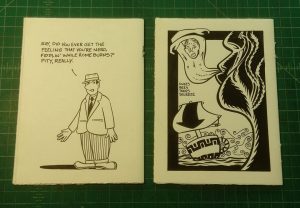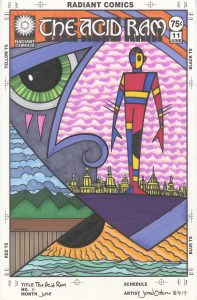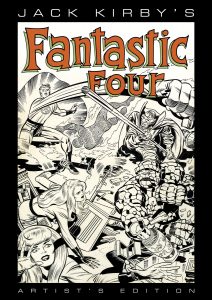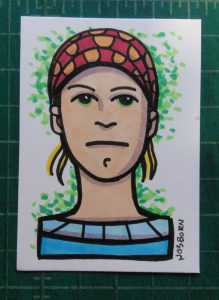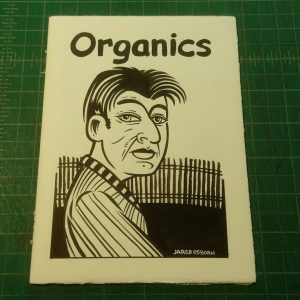
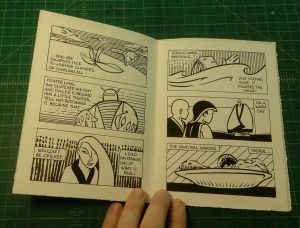
I always find it shocking when I’m rummaging about the place and I find some piece of art that I’ve forgotten I ever made. Though I’ve made a lot of stuff over the decades it really doesn’t happen that often. I scan my art into the computer and look through the files when I need to find something. That mostly means I only glance at things but since I see them it’s rare when something takes me by surprise.
As a lot of folks did back in the 1990s I used to make mini-comics. That’s where you write and draw comics and then print them up as a booklet on a photocopier. They were usually photocopied onto an 8.5×11 inch piece of paper and then the paper was folded in half so the finished comic was 5.75×8 inches. Some people even went smaller and used the paper folded into quarters to get more and smaller pages out of a single sheet of 8.5×11 inch paper. I still have a few copies of mine stuck in a closet somewhere and I remember them all but what I didn’t remember is how I made the last two I ever did.
My usual method for making a mini comic was similar to my method for making a regular comic. I draw the art on individual pages, shrink those pages down to the correct size, paste those pages onto a master sheet (a mechanical in the language of print production) and then use those master sheets to make photocopies from. After the photocopies were made I’d line the sheets of paper up in the right order and then staple and fold them. I even have a long reach stapler because a regular stapler was too short. It’s pretty much a craft project and was easy to do but took time.
What I found while looking at some sketchbooks on a shelf was the original art from my last two mini-comics, a “Delia Charm” and an “Organics” mini. Except the art wasn’t on individual pieces of paper. I actually made a book out of the original art. A mini-comic that was itself a piece of art. Each little book has twelve pages made from three sheets of paper each, drawn on back and front, and then folded in the middle. I didn’t even use staples to hold it together. I used thread to bind them in the place of two staples each. I have the say the thread gives it a nice look. I’m glad I went that route. And yesterday I didn’t remember I ever made such a thing.
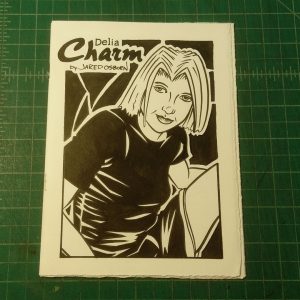
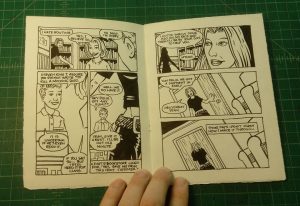
The first mini-comic is “Organics.” That’s the name of a style of comic that I do where there is no literal connection between the story and the pictures. It’s all about making connections. Finding the faces in the clouds. I especially like the front and back covers on this one. The front cover is a twice done picture. I first drew it as a spontaneous ink drawing on textured paper in the late-1990s when I was first learning that technique. I always liked something about the drawing. There was a look in the character’s eyes that works for me. I even recaptured that look when I remade the drawing for this cover. It’s not always possible to recapture a look like that but somehow I did. The back cover is a strange boat and wind thing. I think the inking technique on it is nice and I like the general weirdness of it. The “Knees, bees, trees, squeeze” type is something I used to write all the time when I got stuck and couldn’t think of anything to write. It calmed me.
The inside story has to do with a broke guy named Tony going to an ATM to get twenty dollars and the thoughts that roll through his head on a cold winter day. I think I accidentally called Tony by the wrong name for a panel. Suddenly a Ray is named and not mentioned again. That threw me. There is also a text piece the runs on the inside front and back covers about supernatural silly stuff. I used to write editorial text pieces in my comics as a sort of precursor to blogging.
The second mini-comic is one of my slice-of-life Delia Charm stories. She’s having a rough day and is trying to get through it without losing her mind. She contemplates the very nature of rough days. There is also a terrible Stephen King joke in there. It’s a contemplative little piece over all. The front cover is a decent illustration of Delia and the back cover gives us a cartoon of a man who is also contemplating a bit of life. I like the text piece in this one better than in the other one. It’s about growing up and not going out into the snow anymore.
As physical objects I really like these little books. I think that was my goal with them. I wanted to make precious little books that could be admired even without being read. They’re made on what feels like 140 pound watercolor paper. That is a real sturdy piece of paper with a creamy feel. Touching it is nice. None of the edges are cut either. They’re either the original deckle edges that were on the paper when I bought it or my own deckle edges as I folded and tore the paper rather than cut it. The paper even has a watermark on part of it. Together with the stitched staples it looks really cool.
It was really weird finding these. It’s not like they were really hiding either. They were sitting on a shelf in a couple of small white envelopes. It’s the shelf where I keep my ink books and a bunch of other sketchbooks that I flip through ever now and then. So how did I not notice these for years and years? I don’t know. Just life I guess.
